PEE BOTTLES: How To Take A Wiz In The “Fricken” Cold!
By: GUIDE TODD RUTLEDGE of MT. TRIP Based in Colorado USA
Contact at: www.mountaintrip.com
Howdy all, the following might get me blackballed from the guiding profession for revealing this trade secret, but here you go: Pee Bottle 101.
(Admittedly, that the following mostly pertains to the male readership, as I don’t have any experience using other techniques, but I will throw out some suggestions for the ladies.)
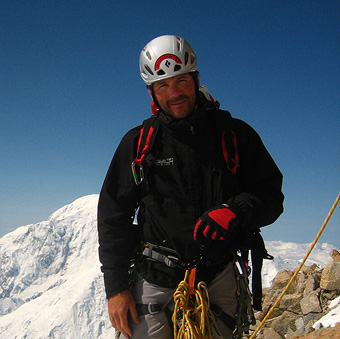
The key to a warm and successful pee when it is sub-zero outside is to first go out and purchase a Wide Mouth, 96 ounce Collapsible Nalgene Canteen. Yeah, yeah, 96 ounces might seem like overkill when you read this at your computer, but you’ll thank me when you’re tent-bound for a couple of days or (more likely) when you forget to dump the previous night’s production and only realize it when you’re zipped up in your bag the following night! I made this recommendation at a gear check last May to three clients and to a new apprentice guide. They all blew the suggestion off while in Anchorage, but were all converts to the idea after a couple of storm days at 14,200’ on Denali. The Collapsible Nalgenes are lighter than a hard bottle and are plenty tough to withstand the abuses of repeated pack stuffings. Lastly, do you know how big your bladder is? I’ve seen climbers find out they have a 34 ounce bladder while using a 1 Liter bottle; it ain’t pretty…
So now that you have the right tool for the job; let’s talk technique. What is the aim of the exercise (pun half intended)? You want to relieve the pressure while minimizing your exposure to the cold and its associated frosty tent walls. The two most efficient techniques that work are the “hip roll” and the “Divine Supine.” The hip roll works well when you didn’t follow the aforementioned 96 ounce bit of advice and when it is not so cold that you’ve had to zip your bag shut. Roll over onto one hip, align your bottle, double check that you’re lined up (this is often a tactile rather than visual affirmation), and let it flow. After the stream has finished, screw the lid back on and DOUBLE CHECK that it is tight.
The “Divine Supine” is an advanced technique that works amazingly well when it is so cold out that you don’t even want to unzip your bag. You can start by aligning your soft, flexible Cantene along your preferred side of elimination before you zip your bag closed. That’s right- begin the night with your bottle inside your bag. Advantages of this, beyond the obvious, are that the crispy yellow frozen ring inside the neck of the bottle will melt and drain to the bottom where your parts won’t touch it. It also lessens the disturbance to your sleep by otherwise bringing a cold bit of plastic into your bag. The 96 ouncer is long enough to allow you to bring the opening across your pelvis to whatever point your anatomy requires for alignment without running the risk of having the bottle too horizontal for containment.
Just lie on your back, bring the bottle across, unscrew the lid, line everything up (see above) and go for it. Remember to DOUBLE CHECK THAT THE LID IS TIGHTLY SEALED! I stress this because I know of someone who never fully awoke from his slumber while performing the task and neglected to tighten the lid- pretty gross… You should get at least several sessions out of the Divine Supine before you need to start paying close attention to the fluid level in the bottle. Again- do you know how big your bladder is? Find out before you try any of these techniques in your sleeping bag.
With practice comes the feeling of security with your technique, so grab a big ol’ Cantene and bring it into bed with you for a few nights prior to your next winter outing. Additional benefits of the pee bottle are that you can use them if it is really windy outside and avoid embarrassing wind-spray. Lastly, if you are using a toilet system in which you need to separate solids from liquids, take your pee bottle with you and use it to avoid peeing into your toilet.
For the ladies: there is a wonderful little tool called the “Freshette”. I think that’s French for “funnel”. It works great and with practice, can eliminate the need to shed layers while on the trail. Yup, you too can pee like the guys! The downside is that you will still need to get onto your knees to make this work in your tent with a pee bottle. All the attributes of the 96 ouncer still pertain, so don’t head into the hills without one!
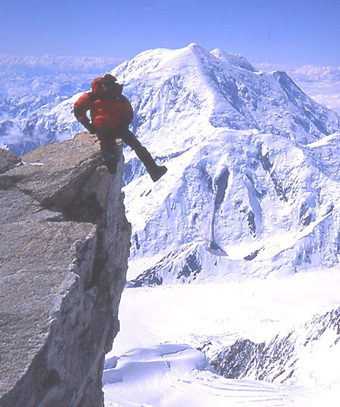
Overboots and Camp Booties on Denali.
By Colby Coombs, mountain guide and owner of Alaska Mountaineering School
Contact at: www.climbalaska.org
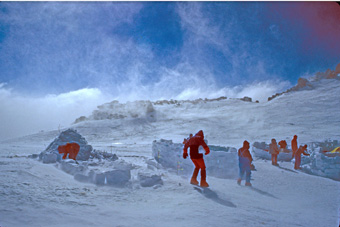
"When climbing an arctic mountain like Denali, I use my 40 Below overboots from day one as a protective layer whenever I wear my 40 Below camp booties. They keep my booties dry and clean especially if I step in someone's spilt spaghetti. I always wear my camp booties in my sleeping bag and know I can get up in the middle of the night, throw on my overboots, and face a raging blizzard without putting my boots on.”
“At 14,200' and above, when I want to protect my feet from the cold while climbing, I make sure all the snow is out of the sole of my boot before putting my overboots on. When I want to switch to my camp booties with overboots, I put my climbing boot shells in a plastic bag to keep them free of snow”.
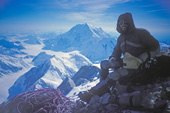
Tip for Having Happy Feet On A Climb
by Guide Eric Simonson of International Mountain Guides
Contact at: www.mountainguides.com
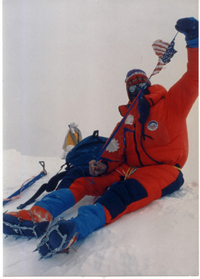
Guide Eric Simonson of International Mountain Guides has this tip to help have happy feet on a climb: He keeps a set of socks in a sealed packed bag, specifically to keep unused until the final summit day. This way you start out with a fresh, clean and warm set of socks. This small tip really makes a difference!
When asked to give some thoughts about socks he said: “Ask ten climbers, and I am sure you will get ten different opinions! I have tried a lot of different sock combinations over the years, trying to find what works the best for me.
For the past fifteen years I have used exclusively the ThorLo Level 3 Mountaineering Sock: This is the only sock I ever use. I do not bother with any kind of “liner” sock. When I am trekking I wear one pair and when I am wearing my climbing boots I wear two pairs. My Koflach climbing boots are fitted to allow enough room for wearing two pairs of these heavy socks. I want thickness for insulation, padding and shock absorption. I have worn this combination for hundreds of ascents of Rainier, for Mt. Everest, Mt. Vinson, and everything in between. I bring plenty of pairs of socks on a big expedition. I also bring some detergent so I can hand wash socks at base camp. Once you wear them a lot, they get all greasy and don’t insulate as well.For summit day I like to save a couple pairs nice and clean, in a plastic bag. That way I know I will a fresh socks for up high. I like to change my socks as soon as I get into camp in the afternoon. Then the dry socks suck some of the moisture out of my boots while I wear them around camp.
Then during the night, I continue to wear these socks to bed and they dry out overnight. The ones I wore during the day, I hang up if possible to dry. If this is not possible, I unzip the leg zippers of my fleece pants and lay the damp socks along my legs, one on each side, between my longjohns and my fleece pants during the night, where they will dry out. Dry socks are gold and you need to keep your feet dry to keep them happy!! In my opinion, this is the secret to warm feet.” Eric Simonson
Please visit www.mountainguides.com to see Eric and the entire International Mountain Guides team!
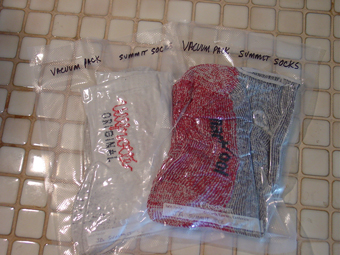
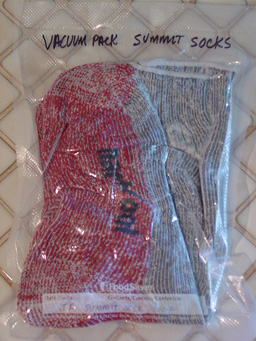
Tips For Keeping Your Feet Warm
By Bill Lokey, Founder, FORTY BELOW, Ltd.
We are the product of a culture that has advanced beyond the necessity of being self reliant on a daily basis. Technology has eliminated problems of heat, thirst, cold, and in many cases hunger and fear. When you go climbing, you take some of your technology with you, however, technology alone may not keep your feet warm.
The fundamental concern is your body's ability to produce heat and the measures taken to conserve it. Cold problems can be prevented by experienced leadership, good physical conditioning, body management, adequate food and water, and using your equipment correctly. Also, different persons' metabolism and reaction to cold may be different. Heat is lost five ways--conduction, convection, radiation, respiration, and evaporation. Using different clothing systems and body management, one can minimize their heat loss.
Your clothing protects your vital resources including your ability to think and act. In our clothing system, we want the following:
1. A dry, ventilated layer next to the skin.
2. A layer of insulation to keep in body heat.
3. An outer cover to keep out wind and water.
4. Key areas of the body where heat loss is most severe(head, wrists, and ankles) should be covered. You can also use this fact to regulate heat loss when you are active so you do not get overheated.
Here are some tips to keeping your feet warm:
1. Drink plenty of liquids and eat a balanced diet.
2. Don't restrict circulation and ventilation around skin.
3. Use a combination of layers on your feet.
4. Keep your legs warm and it will help keep your feet warm.
5. Don't lace your boots too tight.
6. Avoid overheating which causes moisture buildup.
7. Insulate between your boots and crampons. (overboots)
8. Clean your feet at night.
9. Wash your socks. Dirty socks don't insulate as well.
10. Avoid alcohol and tobacco, they may impair peripheral circulation.




